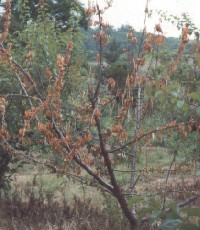|

German Version
Site map
FAIR 3889
Virus diseases
Phytoplasma diseases
AP
ESFY
PD
Pathogen collection
Pathogen detection
Pathogen elimination
Contact us
Related Sites
|
European Stone Fruit Yellows
(ESFY)
 Symptoms of apricot tree decline were observed in France and Italy since
the beginning of the twentieth century: Morvan named the disease associated
with leptonecrosis or with new sprouting in winter ´apricot chlorotic
leaf rolling´ (ACLR). Only 20 years ago these symptoms were associated
with a phytoplasma infection, since phytoplasmas were detectable by EM or
fluorescence microscopy (DAPI) as single cells in sieve tubes and transmission
experiments to other stone fruit and indicator plants were successfully carried
out.
Symptoms of apricot tree decline were observed in France and Italy since
the beginning of the twentieth century: Morvan named the disease associated
with leptonecrosis or with new sprouting in winter ´apricot chlorotic
leaf rolling´ (ACLR). Only 20 years ago these symptoms were associated
with a phytoplasma infection, since phytoplasmas were detectable by EM or
fluorescence microscopy (DAPI) as single cells in sieve tubes and transmission
experiments to other stone fruit and indicator plants were successfully carried
out.
ESFY has been proposed as the common name for phytoplasma-related diseases
in European stone fruits belonging to the 16SrX-B subgroup. Among others it
includes the French ECA or ACLR, which is a quarantaine organism of EPPO,
according to the EPPO certification scheme for virus tested fruit trees.
Stone fruit trees susceptible to phytoplasmas are Japanese plum, apricot and peach,
giving clear symptoms depending on the variety. Others, like European plum,
may be symptomless carriers, while cherries appear to be resistant.
The affected trees show, initially on some branches, apparent symptoms of
deficiency in water and nutrient supply, which is expressed as rolling and
chlorosis, followed by early reddening of leaves and metabolic disorders, leading
to sudden dieback during growing season. Small and wilted fruits and early
autumn leaf coloration followed by an altered behaviour at leaf fall, since dried
leaves persist for long time on the plants, were also observed.
To verify phytoplasma association with the described symptoms, molecular
identification by PCR/RFLP analysis are carried out. Testing of propagation material
may need to become common practice.
|



